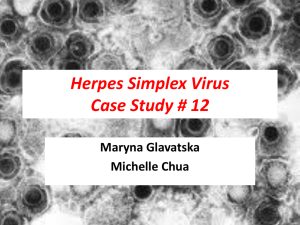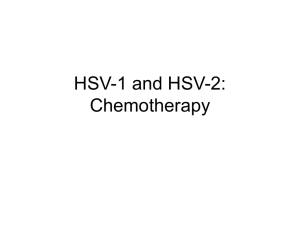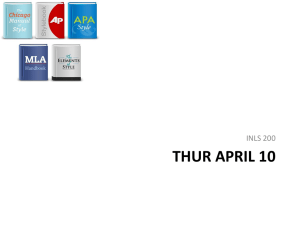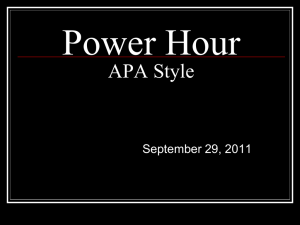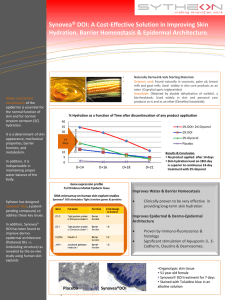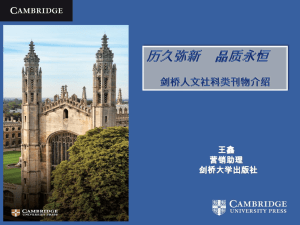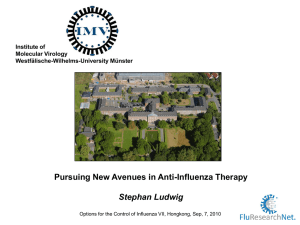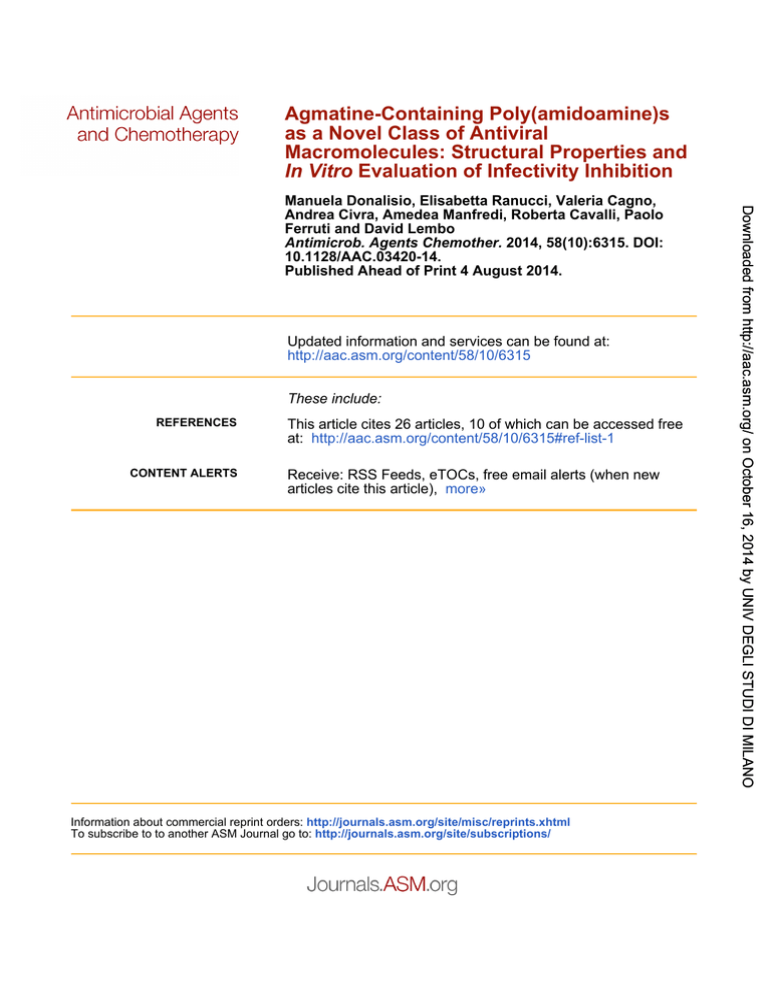
Agmatine-Containing Poly(amidoamine)s
as a Novel Class of Antiviral
Macromolecules: Structural Properties and
In Vitro Evaluation of Infectivity Inhibition
Updated information and services can be found at:
http://aac.asm.org/content/58/10/6315
These include:
REFERENCES
CONTENT ALERTS
This article cites 26 articles, 10 of which can be accessed free
at: http://aac.asm.org/content/58/10/6315#ref-list-1
Receive: RSS Feeds, eTOCs, free email alerts (when new
articles cite this article), more»
Information about commercial reprint orders: http://journals.asm.org/site/misc/reprints.xhtml
To subscribe to to another ASM Journal go to: http://journals.asm.org/site/subscriptions/
Downloaded from http://aac.asm.org/ on October 16, 2014 by UNIV DEGLI STUDI DI MILANO
Manuela Donalisio, Elisabetta Ranucci, Valeria Cagno,
Andrea Civra, Amedea Manfredi, Roberta Cavalli, Paolo
Ferruti and David Lembo
Antimicrob. Agents Chemother. 2014, 58(10):6315. DOI:
10.1128/AAC.03420-14.
Published Ahead of Print 4 August 2014.
Agmatine-Containing Poly(amidoamine)s as a Novel Class of Antiviral
Macromolecules: Structural Properties and In Vitro Evaluation of
Infectivity Inhibition
Dipartimento di Scienze Cliniche e Biologiche, Università degli Studi di Torino, Orbassano, Turin, Italya; Dipartimento di Chimica Organica e Industriale, Università degli
Studi di Milano, Milan, Italyb; Dipartimento di Scienza e Tecnologia del Farmaco, Università degli Studi di Torino, Turin, Italyc
Poly(amidoamine)s (PAAs) are multifunctional tert-amine polymers endowed with high structural versatility. Here we report on
the screening of a minilibrary of PAAs against a panel of viruses. The PAA AGMA1 showed antiviral activity against herpes simplex virus, human cytomegalovirus, human papillomavirus 16, and respiratory syncytial virus but not against human rotavirus
and vesicular stomatitis virus. The results suggest the contribution of both a polycationic nature and side guanidine groups in
imparting antiviral activity.
T
he development of antiviral molecules usually focuses on either preventing virus entry into the host cell or inhibiting virus
replication following host infection. The first strategy may be
based on antiviral polyanionic polymers capable of competitively
blocking the interaction between viral proteins and cell surface
heparan sulfate proteoglycans (HSPGs), which are exploited as
attachment receptors by many viruses (1–4). Notwithstanding the
large number of studies demonstrating their efficacy in preclinical
models, polyanionic polymers somehow failed in clinical trials
(5). Unlike polyanions, polycationic polymers have been less investigated as antiviral compounds. In principle, polycations may
act as antivirals by electrostatically interacting either with the negatively charged cell membrane or with the envelope of lipid-enveloped viruses, thus preventing virus adsorption onto cell surfaces, or by directly inactivating the virus particle. In this context,
it was shown that the cationic poly(acrylic ester) Eudragit E 100,
endowed with a membrane-destabilizing activity, exerts antiviral
activity against a panel of lipid-enveloped viruses (6, 7). Another
study demonstrated that polyethylenimine, a cationic polymer
able to condense DNA and mediate gene transfer into mammalian
cells, inhibits infection by human cytomegalovirus (HCMV) and
human papillomavirus (HPV), a lipid-enveloped virus and a nonenveloped virus, respectively (8).
Poly(amidoamine)s (PAAs) are multifunctional tert-amine
polymers endowed with high structural versatility, obtained by
Michael polyaddition of amines and bis-acrylamides (9). The repeating units of PAAs can be designed to be reminiscent of peptides. For instance, an amphoteric, prevailingly cationic PAA
named AGMA1 is a polymer mimic of the arg-gly-glu peptide
(RGD) (10, 11).
In the search for new antiviral compounds, a minilibrary of
PAAs was screened against a panel of seven viruses, namely, herpes
simplex virus type 1 and 2 (HSV-1, HSV-2), HCMV, HPV-16,
human respiratory syncytial virus (RSV), human rotavirus
(HRV), and vesicular stomatitis virus (VSV), chosen as representative of different virus characteristics, such as the presence or
absence of lipid envelope, a DNA or RNA genome, and HSPG
dependency for virus attachment (12–16).
The minilibrary included three water-soluble PAAs, ISA1,
October 2014 Volume 58 Number 10
ISA23, and AGMA1, whose structures are reported in Fig. 1. The
copolymeric PAA ISA1 (17), containing two randomly distributed
repeating units present in equal amounts, and the homopolymeric
PAAs ISA23 (17, 18) and AGMA1 (10) were prepared as previously reported. AGMA1 fractions with different average molecular weights were obtained by ultrafiltration against water using
membranes with different nominal molecular weight cutoffs, as
previously described (11). ISA1 is weakly cationic, but ISA23 and
AGMA1 are amphoteric, with isoelectric points of ⬃5.2 and
⬃10.3. As reported in Table 1, at pH 7.4, these PAAs have, respectively, ⫹0.55, ⫺0.55, and ⫹0.55 average charges per unit. For
ISA1, the reported value corresponds to the ionization degree of
its tert-amine groups, with no other ionizable groups being present. For ISA23 and AGMA1, the reported figures correspond to
the excess negative-over-positive charges and vice versa, that is,
respectively, ⫺1 plus 0.45 and ⫺1 plus 1.55 per unit. Thus, at pH
7.4, the overall cationic charges of ISA1 and AGMA1 are superficially similar, but a deeper investigation reveals that their real
charge distributions are different.
Antiviral assays were performed by infecting cell monolayers in
the presence of serial dilutions of compounds for 2 h at 37°C to
generate dose-response curves and a selectivity profile of the
PAAs’ antiviral spectra. The inocula were subsequently washed
out and replaced with culture medium containing the same concentration of compounds. The effect on HSV and VSV infections
was evaluated by a standard plaque reduction assay on preseeded
Vero cells in 24-well plates (10 ⫻ 104 cells) infected with 300
PFU/well of clinical isolates of HSV-1 and HSV-2 (19) and VSV
serotype Indiana; after incubation for 24 h (HSV-2 and VSV) or 48
h (HSV-1) at 37°C in 5% CO2, cells were fixed and stained with
Received 21 May 2014 Returned for modification 23 June 2014
Accepted 30 July 2014
Published ahead of print 4 August 2014
Address correspondence to David Lembo, david.lembo@unito.it.
Copyright © 2014, American Society for Microbiology. All Rights Reserved.
doi:10.1128/AAC.03420-14
Antimicrobial Agents and Chemotherapy
p. 6315– 6319
aac.asm.org
6315
Downloaded from http://aac.asm.org/ on October 16, 2014 by UNIV DEGLI STUDI DI MILANO
Manuela Donalisio,a Elisabetta Ranucci,b Valeria Cagno,a Andrea Civra,a Amedea Manfredi,b Roberta Cavalli,c Paolo Ferruti,b
David Lemboa
Donalisio et al.
0.1% crystal violet in 20% ethanol and viral plaques were counted.
The mean plaque count for each drug concentration was expressed as a percentage of the mean plaque count of the control.
In HCMV and RSV inhibition assays, infected cells were fixed
and subjected to virus-specific immunostaining as described previously (20, 21). In these assays, cells were preseeded at a density of
6 ⫻ 103/well in 96-well plates. Hep-2 cells were infected with RSV
strain A2 (60 PFU/well), whereas HELF cells were infected with
HCMV strain AD169 (24 PFU/well). Three days (RSV) or 5 days
(HCMV) postinfection, immunostained viral plaques were microscopically counted.
HPV inhibition assays were performed on preplated 293TT
cells (2 ⫻ 104/well in 96-well plates) using HPV-16 secreted alkaline phosphatase (SEAP) pseudoviruses (PsV) at the final concentration of 1 ng/ml liter⫺1; 3 days postinfection, the SEAP content
in the clarified supernatant was determined as previously deTABLE 1 Physicochemical characteristics of PAAs
Avg negative
charge per
unit at pH 7.4
Avg positive
charge per
unit at pH 7.4
Polymer
na
M
Net avg charge
per unit at pH 7.4
Polydisperse
AGMA1
AGMA14
AGMA17
AGMA120
ISA1
ISA23
10,100
⫹0.55
⫺1.00
⫹1.55
4,500
7,800
20,500
13,600
16,500
⫹0.55
⫹0.55
⫹0.55
⫹0.55
⫺0.55
⫺1.00
⫺1.00
⫺1.00
0.0
⫺1.00
⫹1.55
⫹1.55
⫹1.55
⫹0.55
⫹0.45
a
¯ , number average molecular weight.
M
n
n
¯ ⫽
M
n
⌺ Ni⫻Mi
i⫽1
n
⌺ Ni
i⫽1
where Ni is the number of macromolecules containing i repeating units and Mi is the
weight of macromolecules containing i repeating units.
6316
aac.asm.org
scribed (22). Plasmids used for PsV production were kindly provided by J. Schiller (NCI, Bethesda, MD, USA). Antiviral assays for
rotavirus were carried out on preplated MA104 cells (1 ⫻ 104/well
in 96-well plates) using human rotavirus strain Wa (200 PFU/
well). After 16 h, viral foci were determined by indirect immunostaining (22).
The endpoints of the assays were the effective compound concentration that reduced the viral plaque/focus formation or SEAP
activity by 50% (EC50) in comparison to that in the untreated
control. The F test was used to compare logEC50s, and two-way
analysis of variance was used to analyze the significance between
percentages of infection at the same doses of different compounds
not able to generate EC50s. P values of ⬍0.05 were considered
statistically significant. The EC50s were calculated and all statistical
analyses were performed by using the program PRISM 4 (GraphPad Software, San Diego, CA, USA). The viability of cells preseeded in 96-well plates was determined under identical culture
conditions in antiviral assays (i.e., cell density and time of incubation with compounds) using a CellTiter 96 proliferation assay kit
(Promega, Madison, WI, USA). The 50% cytotoxic concentrations (CC50) were determined using Prism software, and the selectivity index (SI) was calculated by dividing the CC50 by the EC50
(19). All data were generated from duplicate wells in at least three
independent experiments. Heparin was included in the study as a
positive control, being a known inhibitor of HSPG-dependent
viruses (e.g., HSV-1, HSV-2, HCMV, RSV, and HPV-16) (23–26).
As expected, heparin blocked infection by HSPG-dependent viruses but not that by VSV and HRV, which are not dependent on
HSPG (Table 2).
Data reported in Table 2 prompt the following observations.
The PAA antiviral effect was not a consequence of cytotoxicity,
since none of the screened compounds significantly reduced cell
viability at any concentration tested (i.e., up to 300 g/ml); there-
Antimicrobial Agents and Chemotherapy
Downloaded from http://aac.asm.org/ on October 16, 2014 by UNIV DEGLI STUDI DI MILANO
FIG 1 Chemical structures of the AGMA1, ISA1, and ISA23 repeating units.
Antiviral Properties of PAAs
TABLE 2 Antiviral activities of PAAs and heparina
Virus
EC50 (g/ml) (95% CI)
CC50 (g/ml)
SI
AGMA1
HSV-1
HSV-2
HCMV
HPV-16
RSV
HRV
VSV
3.04 (1.75–5.28)
5.34 (1.85–15.4)
0.76 (0.40–1.47)
0.54 (0.53–0.55)
⬎100
⬎100
⬎100
⬎300
⬎300
⬎300
⬎300
⬎300
⬎300
⬎300
⬎98.7
⬎56.2
⬎395
⬎556
NA
NA
NA
AGMA14
HSV-1
HSV-2
HCMV
HPV-16
RSV
HRV
VSV
1.93 (1.43–2.61)
1.35 (0.57–3.17)
0.39 (0.11–1.30)
0.92 (0.53–1.58)
8.87 (6.51–12.1)
⬎100
⬎100
⬎300
⬎300
⬎300
⬎300
⬎300
⬎300
⬎300
⬎155
⬎222
⬎769
⬎326
⬎33.8
NA
NA
AGMA17
HSV-1
HSV-2
HCMV
HPV-16
RSV
HRV
VSV
17.0 (11.4–25.4)
4.80 (3.13–7.35)
4.45 (3.28–5.90)
0.79 (0.44–1.44)
7.44 (3.11–17.8)
⬎100
⬎100
⬎300
⬎300
⬎300
⬎300
⬎300
⬎300
⬎300
⬎17.6
⬎62.5
⬎67.4
⬎380
⬎40.3
NA
NA
AGMA120
HSV-1
HSV-2
HCMV
HPV-16
RSV
HRV
VSV
5.10 (3.21–8.10)
2.82 (1.72–4.64)
4.14 (2.50–6.86)
0.72 (0.50–1.06)
1.37 (1.11–1.68)
⬎100
⬎100
⬎300
⬎300
⬎300
⬎300
⬎300
⬎300
⬎300
⬎58.8
⬎106
⬎72.5
⬎417
⬎219
NA
NA
ISA1
HSV-1
HSV-2
HCMV
HPV-16
RSV
HRV
VSV
⬎100
⬎100
1.26 (0.79–2.00)
3.55 (1.97–6.40)
9.54 (5.51–16.5)
⬎100
⬎100
⬎300
⬎300
⬎300
⬎300
⬎300
⬎300
⬎300
NA
NA
⬎238
⬎84.5
⬎31.4
NA
NA
ISA23
HSV-1
HSV-2
HCMV
HPV-16
RSV
HRV
VSV
⬎100
⬎100
⬎100
⬎100
⬎100
⬎100
⬎100
⬎300
⬎300
⬎300
⬎300
⬎300
⬎300
⬎300
NA
NA
NA
NA
NA
NA
NA
Heparin
HSV-1
HSV-2
HCMV
HPV-16
RSV
HRV
VSV
5.22 (4.22–6.45)
0.67 (0.39–1.18)
0.38 (0.24–0.64)
2.88 (1.81–4.57)
0.05 (0.04–0.06)
⬎100
⬎100
⬎300
⬎300
⬎300
⬎300
⬎300
⬎300
⬎300
⬎57.5
⬎448
⬎789
⬎104
⬎6,000
NA
NA
a
EC50, 50% effective concentration; 95% CI, 95% confidence interval; CC50, 50%
cytotoxic concentration; SI, selectivity index; NA, not assessable.
fore, their CC50 values may be considered to be higher than 300
g/ml in all the cell lines tested.
Polydisperse AGMA1 strongly inhibited infections by HSV-1,
HSV-2, HCMV, and HPV-16, generating dose-response curves
October 2014 Volume 58 Number 10
with EC50s of 3.04, 5.34, 0.76, and 0.54 g/ml, respectively. Interestingly, AGMA1 was significantly more active than heparin
against HSV-1 and HPV-16 infections, whereas it was as active as
heparin against HCMV infection (P ⬍ 0.05). In contrast, polydisperse AGMA1 was inactive against RSV, HRV, and VSV.
To evaluate the influence of molecular weight on antiviral
potency, three additional linear AGMA1 fractions were pre n, 4,500), AGMA17 (M
n, 7,800), and
pared, namely, AGMA14 (M
n, 20,500) (Table 1). As depicted in Table 2, fracAGMA120 (M
tions with lower and higher molecular weights than that of poly n, 10,100) maintained inhibitory activity
disperse AGMA1 (M
against HSV-1, HSV-2, HCMV, and HPV-16 although to different extents. AGMA14 showed a stronger anti-HSV-1 activity than
that of heparin, and all fractions were more active than heparin
against HPV-16 infection (P ⬍ 0.05). No statistically significant
differences were observed between the EC50 of heparin and the
EC50s of AGMA14 against HSV-2 and HCMV infections and between the EC50 of heparin and the EC50 of AGMA120 against
HSV-1 infection.
Unlike polydisperse AGMA1, AGMA14, AGMA17, and
AGMA120 were also active against RSV, with EC50 values of 8.87,
7.44, and 1.37 g/ml, respectively. Both of the polydisperse
AGMA1 and AGMA1 fractions failed to display any significant
inhibitory effect against HRV and VSV. The antiviral activity of
AGMA1 seems not to be dependent on its molecular weight for
HSV-1, HSV-2, HCMV, and HPV-16; instead, there is a clear
relationship between the AGMA1 fractions’ sizes and their antiRSV potency. Explaining why polydisperse AGMA1 did not exert
a detectable anti-RSV activity while all of the size fractions did
demands further investigation.
Polymers do not consist of a single molecular species but rather
of families of homologous species differing in their numbers of
repeating units. Therefore, it is considered inappropriate to adopt
the molar concept describing their properties. Nevertheless, to
compare activities across compounds, Table 3 shows the EC50s of
AGMA1 fractions and heparin expressed in terms of molarity instead
of g/ml, considering the average molecular weight reported in Table
1. It was not possible to convert the average molecular mass of polydisperse AGMA1 in terms of molar equivalents, since its molecular
mass is not univocally defined. Interestingly, the relationship between
the AGMA1 fractions’ sizes and their anti-RSV potency, reported in
the text where data are expressed in terms of g/ml, is preserved.
Furthermore, AGMA17 and AGMA120 preserved a higher antiHPV-16 activity than that of heparin (P ⬍ 0.05). In contrast, the
antiviral activity of AGMA14 in terms of molarity is lower than that in
terms of g/ml; its activity is similar to that of heparin against HSV-1
and HPV-16 infections and is lower than that of heparin against
HSV-2 and HCMV (P ⬍ 0.05). This behavior might be ascribed to a
greater rigidity of the polymer with the lowest molecular weight. Because all of the polymers are polyelectrolytes, it is necessary to take
into account that the charge density markedly affects the dynamic
rheological properties, the flexibility, and the chain entanglements.
Increased polymer charge density results in intermolecular electrostatic repulsion and increased polymer solubility.
Next, to investigate whether the activity of AGMA1 was specifically due to the structure of its repeating unit, the antiviral activities of ISA1 and ISA23 were assessed. Overall, while AGMA1 was
active against HSV-1, HSV-2, HCMV, RSV, and HPV-16 infection, ISA1 was active only against HCMV and RSV, with a lower
activity than that of heparin, and was as active as heparin against
aac.asm.org 6317
Downloaded from http://aac.asm.org/ on October 16, 2014 by UNIV DEGLI STUDI DI MILANO
Compound
Donalisio et al.
TABLE 3 Antiviral activities of poly(amidoamine)s expressed in terms
of approximate molar valuesa
Virus
EC50 (M) (95% CI)
CC50 (M)
AGMA14
HSV-1
HSV-2
HCMV
HPV-16
RSV
HRV
VSV
0.43 (0.30–0.61)
0.30 (0.11–0.80)
0.33 (0.09–1.27)
0.20 (0.12–0.33)
1.97 (1.44–2.69)
⬎22.22
⬎22.22
⬎66.67
⬎66.67
⬎66.67
⬎66.67
⬎66.67
⬎66.67
⬎66.67
AGMA17
HSV-1
HSV-2
HCMV
HPV-16
RSV
HRV
VSV
2.18 (0.65–7.33)
0.61 (0.38–1.00)
0.56 (0.41–0.76)
0.10 (0.06–0.18)
0.95 (0.40–2.28)
⬎12.82
⬎12.82
⬎38.46
⬎38.46
⬎38.46
⬎38.46
⬎38.46
⬎38.46
⬎38.46
AGMA120
HSV-1
HSV-2
HCMV
HPV-16
RSV
HRV
VSV
0.25 (0.16–0.40)
0.14 (0.08–0.23)
0.20 (0.12–0.33)
0.04 (0.02–0.51)
0.07 (0.05–0.08)
⬎4.87
⬎4.87
⬎14.63
⬎14.63
⬎14.63
⬎14.63
⬎14.63
⬎14.63
⬎14.63
Heparin
HSV-1
HSV-2
HCMV
HPV-16
RSV
HRV
0.38 (0.30–0.49)
0.04 (0.03–0.07)
0.03 (0.02–0.05)
0.21 (0.13–0.36)
0.01 (0.00–0.01)
⬎7.30
⬎21.90
⬎21.90
⬎21.90
⬎21.90
⬎21.90
⬎21.90
a
EC50, 50% effective concentration; 95% CI, 95% confidence interval; CC50, 50%
cytotoxic concentration.
HPV-16 (P ⬍ 0.05). ISA23 was inactive in all cases. At pH 7.4, both
AGMA1 and ISA1 are positively charged, whereas ISA23 is negatively charged. It is known that polycationic polymers establish
ionic interactions with the cell surface HSPG (27, 28), a feature
that may impart antiviral activity to these compounds. This feature, along with the finding that the active PAAs have the same
antiviral activity spectrum as heparin, supports the hypothesis
that PAAs may exert their antiviral action, at least in part, by
interacting with HSPG, thus preventing virus attachment. However, notwithstanding the fact that AGMA1 and ISA1 carry the
same density of positive charges, i.e., ⫹0.55, AGMA1 showed a
greater activity for HSV-1, HSV-2, and HPV-16. This may be due
to the different real charge distributions on the macromolecules
and to their side guanidine groups reinforcing membrane interactions, according to their well-known chaotropic properties (29).
In contrast, the guanidine side group does not seem to be necessary for the anti-HCMV activity. Furthermore, a different chain
entanglement might explain the different activity of AGMA1 with
respect to that of RSV. Overall, these results provide a starting
point to tailor a macromolecule with enhanced antiviral activity
against a selected virus. Future work will be focused on narrowing
the molecular mass distribution of PAA samples to assist in preclinical development.
Studies are ongoing to elucidate the mechanisms of action of
the active PAAs and their antiviral potential and biocompatibility
profile in preclinical models.
6318
aac.asm.org
This work was supported by a grant from Ricerca Finanziata
dall’Università degli Studi di Torino (ex 60%) 2012 to D.L.
REFERENCES
1. Spillmann D. 2001. Heparan sulfate: anchor for viral intruders? Biochimie
83:811– 817. http://dx.doi.org/10.1016/S0300-9084(01)01290-1.
2. Liu J, Thorp SC. 2002. Cell surface heparan sulfate and its roles in assisting viral infections. Med. Res. Rev. 22:1–25. http://dx.doi.org/10.1002
/med.1026.
3. Tiwari V, Maus E, Sigar IM, Ramsey KH, Shukla D. 2012. Role of
heparan sulfate in sexually transmitted infections. Glycobiology 22:1402–
1412. http://dx.doi.org/10.1093/glycob/cws106.
4. Rusnati M, Vicenzi E, Donalisio M, Oreste P, Landolfo S, Lembo D.
2009. Sulfated K5 Escherichia coli polysaccharide derivatives: a novel class
of candidate antiviral microbicides. Pharmacol. Ther. 123:310 –322. http:
//dx.doi.org/10.1016/j.pharmthera.2009.05.001.
5. Pirrone V, Wigdahl B, Krebs FC. 2011. The rise and fall of polyanionic
inhibitors of the human immunodeficiency virus type 1. Antiviral Res.
90:168 –182. http://dx.doi.org/10.1016/j.antiviral.2011.03.176.
6. Alasino RV, Ausar SF, Bianco ID, Castagna LF, Contigiani M, Beltramo
DM. 2005. Amphipathic and membrane-destabilizing properties of the
cationic acrylate polymer Eudragit E100. Macromol. Biosci. 5:207–213.
http://dx.doi.org/10.1002/mabi.200400168.
7. Alasino RV, Bianco ID, Vitali MS, Zarzur JA, Beltramo DM. 2007.
Characterization of the inhibition of enveloped virus infectivity by the
cationic acrylate polymer eudragit E100. Macromol. Biosci. 7(9-10):1132–
1138. http://dx.doi.org/10.1002/mabi.200700102.
8. Spoden GA, Besold K, Krauter S, Plachter B, Hanik N, Kilbinger AF,
Lambert C, Florin L. 2012. Polyethylenimine is a strong inhibitor of
human papillomavirus and cytomegalovirus infection. Antimicrob.
Agents Chemother. 56:75– 82. http://dx.doi.org/10.1128/AAC.05147-11.
9. Ferruti P. 2013. Poly(amidoamine)s: past, present, and perspectives. J.
Polymer Sci. A Polymer Chem. 51:2319 –2353. http://dx.doi.org/10.1002
/pola.26632.
10. Ferruti P, Franchini J, Bencini M, Ranucci E, Zara GP, Serpe L, Primo
L, Cavalli R. 2007. Prevailingly cationic agmatine-based amphoteric polyamidoamine as a nontoxic, nonhemolytic, and “stealthlike” DNA complexing agent and transfection promoter. Biomacromolecules 8(5):1498 –
1504. http://dx.doi.org/10.1021/bm061126c.
11. Cavalli R, Bisazza A, Sessa R, Primo L, Fenili F, Manfredi A, Ranucci E,
Ferruti P. 2010. Amphoteric agmatine containing polyamidoamines as
carriers for plasmid DNA in vitro and in vivo delivery. Biomacromolecules 11(10):2667–2674. http://dx.doi.org/10.1021/bm100685t.
12. Roizman B, Knipe MM, Whitley RJ. 2007. Herpes simplex viruses, p
2501–2601. In Fields BN, Knipe DM, Howley PM (ed), Fields virology.
Lippincott-Raven, Philadelphia, PA.
13. Lowy DR, Howley PM. 2001. Papillomaviruses, p 2231–2264. In Fields
BN, Knipe DM, Howley PM (ed), Fields virology. Lippincott-Raven, Philadelphia, PA.
14. Collins PL, Crowe JE, Jr. 2007. Respiratory syncytial virus and metapneumovirus, p 1601–1646. In Knipe DM, Howley PM (ed) Fields virology, 5th ed. Lippincott Williams and Wilkins, Philadelphia, PA.
15. Landolfo S, Gariglio M, Gribaudo G, Lembo D. 2003. The human cytomegalovirus. Pharmacol. Ther. 98:269 –297. http://dx.doi.org/10.1016/S0163
-7258(03)00034-2.
16. Cox E, Christenson JC. 2012. Rotavirus. Pediatr. Rev. 33:439 – 445. http:
//dx.doi.org/10.1542/pir.33-10-439.
17. Richardson S, Ferruti P, Duncan R. 1999. Poly(amidoamine)s as potential endosomolytic polymers: evaluation in vitro and body distribution in
normal and tumour-bearing animals. J. Drug Target. 6:391– 404. http://dx
.doi.org/10.3109/10611869908996846.
18. Ferruti P, Manzoni S, Richardson SCW, Duncan R, Patrick NG, Mendichi R, Casolaro M. 2000. Amphoteric linear poly(amido-amine)s as
endosomolytic polymers: correlation between physicochemical and biological properties. Macromolecules 33:7793–7800. http://dx.doi.org/10
.1021/ma000378h.
19. Donalisio M, Nana HM, Ngono Ngane RA, Gatsing D, Tiabou Tchinda
A, Rovito R, Cagno V, Cagliero C, Boyom FF, Rubiolo P, Bicchi C,
Lembo D. 2013. In vitro anti-herpes simplex virus activity of crude extract
of the roots of Nauclea latifolia Smith (Rubiaceae). BMC Compl. Altern.
Med. 13:266. http://dx.doi.org/10.1186/1472-6882-13-266.
Antimicrobial Agents and Chemotherapy
Downloaded from http://aac.asm.org/ on October 16, 2014 by UNIV DEGLI STUDI DI MILANO
Compound
ACKNOWLEDGMENT
Antiviral Properties of PAAs
October 2014 Volume 58 Number 10
25. Hallak LK, Spillmann D, Collins PL, Peeples ME. 2000. Glycosaminoglycan sulfation requirements for respiratory syncytial virus infection. J. Virol. 74:10508 –10513. http://dx.doi.org/10.1128/JVI.74.22
.10508-10513.2000.
26. Joyce JG, Tung J-S, Przysiecji CT, Cook JC, Lehman ED, Sands JA,
Jansen KU, Keller PM. 1999. The L1 major capsid protein of human
papillomavirus type 11 recombinant virus-like particles interacts with
heparin and cell-surface glycosaminoglycans on human keratinocytes. J.
Biol. Chem. 274:5810 –5822. http://dx.doi.org/10.1074/jbc.274.9.5810.
27. Poon GM, Gariépy J. 2007. Cell-surface proteoglycans as molecular portals for cationic peptide and polymer entry into cells. Biochem. Soc. Trans.
35:788 –793. http://dx.doi.org/10.1042/BST0350788.
28. Mislick KA, Baldeschwieler JD. 1996. Evidence for the role of proteoglycans in cation-mediated gene transfer. Proc. Natl. Acad. Sci. U. S. A. 93:
12349 –12354. http://dx.doi.org/10.1073/pnas.93.22.12349.
29. Myers JK, Pace CN, Scholtz JM. 1995. Denaturant m values and heat
capacity changes: relation to changes in accessible surface areas of protein unfolding. Protein Sci. 4:2138 –2148. http://dx.doi.org/10.1002
/pro.5560041020.
aac.asm.org 6319
Downloaded from http://aac.asm.org/ on October 16, 2014 by UNIV DEGLI STUDI DI MILANO
20. Donalisio M, Rusnati M, Cagno V, Civra A, Bugatti A, Giuliani A, Pirri
G, Volante M, Papotti M, Landolfo S, Lembo D. 2012. Inhibition of
human respiratory syncytial virus infectivity by a dendrimeric heparan
sulfate-binding peptide. Antimicrob. Agents Chemother. 56:5278 –5288.
http://dx.doi.org/10.1128/AAC.00771-12.
21. Funaro A, Gribaudo G, Luganini A, Ortolan E, Lo Buono N, Vicenzi E,
Cassetta L, Landolfo S, Buick R, Falciola L, Murphy M, Garotta G,
Malavasi F. 2008. Generation of potent neutralizing human monoclonal
antibodies against cytomegalovirus infection from immune B cells. BMC
Biotechnol. 8:85. http://dx.doi.org/10.1186/1472-6750-8-85.
22. Donalisio M, Rusnati M, Civra A, Bugatti A, Allemand D, Pirri G,
Giuliani A, Landolfo S, Lembo D. 2010. Identification of a dendrimeric
heparan sulfate-binding peptide that inhibits infectivity of genital types of
human papillomaviruses. Antimicrob. Agents Chemother. 54:4290 –
4299. http://dx.doi.org/10.1128/AAC.00471-10.
23. WuDunn D, Spear PG. 1989. Initial interaction of herpes simplex virus
with cells is binding to heparan sulphate. J. Virol. 63:52–58.
24. Kari B, Gehrz R. 1992. A human cytomegalovirus glycoprotein complex
designated gC-II is a major heparin-binding component of the envelope. J.
Virol. 66:1761–1764.

